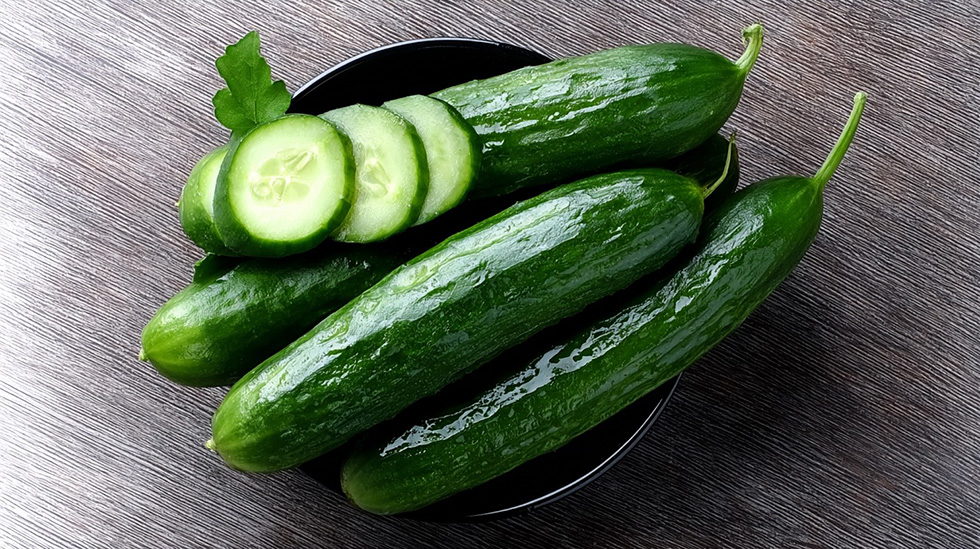English cucumber – the elongated ambassador of freshness
If there is one vegetable that can be found in almost every kitchen in summer, it is the English cucumber! Long, slender, crisp and cooling – just like a refreshing summer shower. But how much do you really know about it? Here’s all you need to know about this luscious, vitamin-packed delicacy that many people call ‘salad cucumber’! 🥒

The English cucumber (Latin: Cucumis sativus) is a member of the gourd family and probably originated in India, where it has been cultivated for thousands of years. It was introduced to European cuisine by the Greeks and Romans and is now at home almost anywhere there is plenty of sunshine and water.
It is worth knowing the differences between the different cucumber varieties:
- English cucumber: a long, thin, smooth-skinned variety with few seeds and very juicy flesh. Usually used raw, in salads and sandwiches. The flavour is mild, slightly sweet and refreshing.
- Pickling cucumbers: a shorter, more compact variety with a ruffled skin and a slightly more distinctive flavour. Great fresh or pickled.
- Fermenting cucumbers: similar to truss cucumbers, but refers to medium sized, younger specimens harvested specifically for pickling.
Kitchen importance – 5/5
The English cucumber deserves an A. Why? Because it has its place in almost every fresh, summer dish: in salads, cold dishes, dips, and even on its own, sprinkled with a little salt, it’s delicious. It’s also a favourite in Mediterranean, Balkan, Middle Eastern and Northern cuisines. Universal, practical and beautiful – that’s all you need!
Which part is edible?
The edible part of the cucumber is the fruit itself, which is eaten in its skin. The skin is thin and doesn’t need to be peeled – in fact, it contains many of the nutrients. The seeds can also be eaten, as English cucumbers usually contain few soft seeds. The stems, leaves and flowers are not edible, they are not suitable for eating, and some parts may even be slightly bitter.
Health under the skin
English cucumber has many beneficial effects:
- 95% water – excellent moisturiser
- Rich in vitamin C, vitamin K, potassium and antioxidants
- Good for digestion – especially if you eat it in its shell
- Also known to have anti-inflammatory and diuretic effects
- Your skin will thank you – applied externally, it cools and reduces puffiness
Folk medicine considers it a diuretic, cooling and digestive vegetable. It is also recommended for dieters and diabetics because of its low calorie content.
Cultivation – where do English cucumbers grow?
English cucumbers are typically warm-hardy plants, grown both outdoors and in greenhouses. The largest producers in Europe are Spain, the Netherlands, Greece and Turkey. It is also cultivated in Hungary in significant quantities, mainly under greenhouse conditions.
Domestic English cucumbers are mostly available in the shops from April to September. In the winter months, you are almost certain to find imported products – mainly Spanish or Dutch cucumbers.
How to choose a really good English cucumber?
- Colour: bright, even green skin – yellowing is a sign of ageing
- To the touch: should be firm, hard – if soft or flabby, no longer fresh
- Surface: smooth, shiny skin, no spots, no damage
Size is not everything! Cucumbers that are too big may be wetter and less tasty. A medium, “handy” size is ideal.
Storage – cool but smart
English cucumbers are best placed in the vegetable crisper in the fridge at a temperature of 8-10°C. Do not put them in the coldest part of the fridge as they are sensitive to cold – they will become soft and lose their freshness. Ideally, store wrapped in paper towels in a perforated bag. Do not store with ethylene-emitting fruits (e.g. apples, bananas) as they will spoil more quickly.
International culinary – how others use it?
- Greece: the soul of Tzatziki
- Turkey: a base for yoghurt salads such as cacık
- India: in salads, pickles, with spices
- Japanese: used for pickled cucumber salads with soy sauce or sesame oil
- Scandinavian countries: pickling with sugar and vinegar, with meat dishes
Recipe – Tzatziki, the Greek miracle
Ingredients:
- 1 English cucumber
- 2 cloves garlic
- 2 dl Greek yoghurt
- 1 ec. olive oil
- fresh dill
- salt, pepper, lemon juice
Preparation: grate the cucumber, lightly salt and squeeze out the juice. Add the yoghurt, crushed garlic, olive oil, finely chopped dill, a little lemon juice, salt and pepper – and you’re done! Serve with toast, pita, meat or just on its own – delicious! 😋
Kitchen tips and spices
- Don’t cook! English cucumbers are best raw – they lose their freshness and texture when cooked
- Goes well with: dill, mint, parsley, lemon, garlic, yoghurt
- What not to add: sweet spices (e.g. cinnamon, cloves), over-spiced sauces
- Diced, sliced, sliced lengthways – try it in new shapes!
Summary
English cucumber is not only refreshing and healthy, but also versatile. It’s readily available, easy to use and one of the best vegetables of summer – whether it’s a quick salad or a Greek-inspired dinner. Just pick it up, slice it up and you’re ready for a refreshing green treat! 🥗✨
